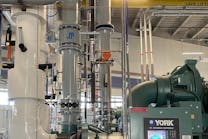As it pertains to buildings, life-cycle-cost analysis is a process of determining total cost of ownership, from construction to operation and maintenance to demolition.
This article examines LCCA from a commissioning (Cx) perspective, focusing on the ways in which Cx can ensure quality and preserve the value and intent of LCCA.
What Is Commissioning?
Cx is a quality-assurance process, one for ensuring building design and construction are delivered successfully and integrated to meet owner project requirements (OPR). A Cx team can promote better project outcomes by using LCCA.
A Cx provider assembles a team including representatives of the construction firm, the owner, and the design team. Cx makes sure design adheres to OPR.
Rule #1: The Building Owner Is King/Queen
Though the purpose of LCCA is to provide an understanding of the cost of constructing, operating and maintaining, decommissioning, and demolishing a building, the owner may wish to include less financially tangible items, such as environmental and social impacts. These are important; because they cannot easily be communicated on a spreadsheet is no reason to discount or ignore them.
Owners understand building use and impacts as they relate to the owner’s core business. They tend to focus on building use and purpose in relationship to the costs and impacts presented by LCCA. Just as OPR are reviewed and updated as part of Cx, the engineering aspects of LCCA should be reviewed and updated as part of Cx. LCCA and OPR should be viewed simultaneously throughout a project.
Basic Structure of LCCA
The first and most important step in performing LCCA is defining the mission of the building and ensuring it meets the owner’s business needs.
Where will the building be constructed? How much will the land cost to obtain? These questions are important because environmental impacts weigh heavily in business decisions. The owner needs to understand traditional environmental concerns such as geology. For example, a facility’s location may be on or near a water table, which could result in extra costs.
Options related to building-system infrastructure need to be well-conceived, carefully prepared, and practical. The financial prospectus of operation of a facility should relate to how materials and building systems are operated and maintained. For example, use of security systems that integrate with HVAC may be an option considered as part of LCCA.
Comparative analysis should be performed for materials and methods of construction, communication and other technologies, HVAC systems, and staffing and O&M strategies. Ideal LCCA presents well-defined options for an owner to consider.
Pre-design and Design Phase
The Cx team recognizes OPR during the preliminary design phase. Well-produced OPR guide all aspects of design, construction, and operation. The Cx process involves regular review of a project with respect to the OPR, which is a living document. LCCA is reviewed side-by-side with OPR to identify any discrepancies. Waiting until construction to understand the owner’s plans are based on a strategy not captured by the OPR is unacceptable.
The Cx provider may find key aspects of the LCCA were not incorporated into the OPR. For example, the LCCA may favor meeting HVAC needs with a thermal-energy-storage system utilizing chilled- water storage. By the time the OPR were generated, however, that plan shifted to another TES strategy, such as utilization of ice storage or solar generation combined with advanced battery systems. Variances in HVAC design affect O&M, with some designs requiring less utility expense, but more resources for maintenance and upkeep.
Meanwhile, different HVAC strategies have different environmental impacts — some systems minimize environmental impact, but have negative social impacts; for example, the owner may have expressed in the LCCA a desire to promote local hiring, but system servicing requires expertise lacking among local workers.
System Integration and Interfacing
The most value Cx brings to LCCA is spotlighting impracticalities related to technology utilization. LCCA may introduce a homogenous and impractical vision of integrating technologies not yet proven to provide robust and reliable duty. The inverse of this is the OPR and project designs not recognizing the LCCA; the OPR drafters and design team may have dismissed the LCCA as visionary and departed from key aspects of it.
If the Cx authority provided both the OPR and LCCA, issues related to meeting the owner’s intent will be easier to identify. If the architecture, engineering, and construction team is not able to relate the LCCA to the OPR, the project may not fully satisfy the client’s needs.
The Cx provider will work with various facility-team members and relate the LCCA to them. For example, the LCCA addresses costs associated with maintenance, but the analysis may have been produced in a bubble, without A/E/C participation. Studies performed by Naval Facilities Engineering Command showed LCCA reduces construction and operation costs. NAVFAC also reports one of the hurdles of producing efficient facilities is the lack of integration of LCCA into facility design and construction.1
Construction Phase
During construction, the Cx team will ensure a service and operation plan is in place. It also will ascertain whether facility systems are installed appropriately and operationally tested. The Cx provider will weigh the owner’s O&M strategy to ensure the preparation and training needs of operations and service providers are met.
For example, the LCCA may be focused on advance technologies and fault-detection analytics, but the general contractor’s training plan is designed to provide traditional preventive maintenance. When the Cx provider is on board and service providers are in place, they will be able to vet assumptions made during LCCA drafting.
Acceptance and Post- Acceptance Phase
Following construction, the Cx team may be involved in monitoring and trending facility performance. Findings should be compared to the LCCA, and the LCCA’s theoretical projection for utility costs should be compared to a projection based on actual readings. If there is a significant difference, the owner will value the insight gained from recording the deviation and providing a gap analysis. The long-term financial impacts associated with inaccurate utility- cost mapping are obvious.
Conclusion
LCCA may seem remote to a project’s A/E/C team. It may be received as visionary and abstract because it attempts to accurately predict total costs from construction, operation, and demolition. A LCCA is a milestone statement representing the owner’s financial design for a facility. OPR are expected to be revised during a project, but if the LCCA becomes detached from the project, the owner’s long-term business plans will be disrupted.
Referencing the LCCA during Cx and frequently comparing it to the OPR is more likely to result in the owner’s holistic business agenda being met.
1 Wiles, S.W. (1997). Analysis of life cycle cost concepts and their implementation by the Naval Facilities Engineering Command. Thesis (M.S. in Civil Engineering), Purdue University. Available at http://bit.ly/Wiles_0797









